July 15 — August 5, 2002


THE BIG PICTURE
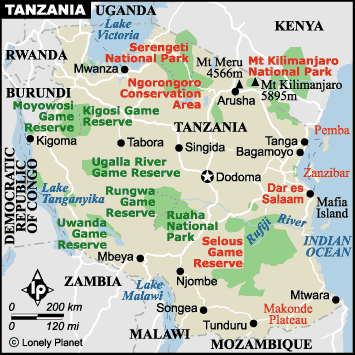
We flew to Tanzania via Minneapolis (3 hours) and Amsterdam (9 hours), arriving
at the Kilimanjaro International Airport (13 hours) located near Arusha.
We spent two nights in Arusha where we safaried Arusha
National Park (the green area next to
the A in Arusha) for a day; we camped six days on the way to the summit
Mt. Kilimanjaro; we rested one night in Arusha,
then camped three nights in Serengeti National
Park; we spent two nights at the Serena
Lodge at the Ngorongoro Crater (about
where the last “o” in Nogorongoro is); we drove back to Arusha Airport
and flew to the island of Zanzibar for
four nights, two in Stone Town on the west side of the island and two on
the east coast of the island. Our return flight began from Zanzibar to
Arusha Airport, transferred to Kilimanjaro International Airport, a flight
to Dar es Salaam, Amsterdam, Detroit, and finally Denver.
TANZANIA: MISCELLANEOUS NOTES
As a young stamp collector,
Tanganyika and Zanzibar were to me among the most exotic of foreign countries.
I especially was intrigued by Zanzibar: I liked saying the name, and I
was fascinated by the images of the various sultans who appeared on the
early stamps. To me it sat somewhere at the end of the world. Tanganyika
was equally fascinating for the animals and safaris. Going there was a
child’s fantasy come true.
The trip was also the sixth
great trip we have taken in our lives. The previous five Great Trips were
the UK and Ireland (1982), rafting the Grand Canyon (1995), hiking Mexico’s
Copper
Canyon (1998), and touring Australia
, New Zealand, and
Fiji
(1999), and Machu
Picchu (2001). The trips were outstanding because we learned a great
deal from each experience and because of the congeniality of the people
we traveled with and met on the trip. What makes each of the trips great
is that we don’t think we could go back; the repeat trip would likely fall
short—perhaps even spoil our memory—of the original experience. Tanzania
is one of these.
1. HISTORY
Talk about a long history!
Tanzania may well be the cradle of the human race. Excavations by Louis
and Mary Leaky in northern Tanzania have revealed fossil remains of our
ancestors from two million years ago. Human history has been dated to about
10,000 B.C.E. with evidence of Khosian people (a language group best known
for “click” sounds) living in the Olduvai Gorge area. They encountered
Cushitic people migrating from the north about 6,000 B.C.E. Starting about
1,000 B.C.E., Bantu speaking people from west Africa regions arrived over
a period of years. Later, Nilotic people migrated from the Sudan region;
the Maasai are
part of this group who continue to lead a traditionally pastoral, nomadic life.
The east coast evolved from quite different cultural influences: beginning in about 300 B.C.E., the Greeks traded with the people in the area whom they called Azania. A thousand years later, traders arrived from Arabia, Persia, and other Islamic areas, out of which grew Swahili, the national language of Tanzania. The language, properly called Kiswahili, (which is Swahili for Swahili!) is an amalgam of Bantu, Arabic, and Persian. These early traders were followed by Chinese, Indian, and finally European merchants beginning with the Portuguese in the 16th century. Portugal controlled the entire east coast of Africa until the early 1700s when the Sultan of Oman gained control and moved his capital to Zanzibar.
The slave trade flourished in this period. European explorers (notably Richard Burton and John Speke) and missionaries (notably David Livingstone) brought reports that encouraged colonization. Germany and Great Britain sought a political foothold; the Germans established German East Africa in the last half of the 19th century until they were ousted by the British following World War I. Pan-African nationalism in the 1950s led to the British granting self-government in 1961, and a year later Tanganyika became independent with Julius Nyerere, a former school teacher, as the first president.
Zanzibar, in the meantime, broke politically from the British in 1963 and a year later joined with Tanganyika to form the new independent country, first called the United Republic of Tanganyika and, five months later, Tanzania.
Among Nyerere’s first moves were to change the language of government and education from English to Swahili, create a strongly socialist state (some claimed it was closer to Chinese Communism than Swedish socialism), and foster the ujamaa village, a self-sufficient agricultural collective designed to encourage social equality and self-reliance. Though ultimately unsuccessful—today’s Tanzanians are energetically capitalists—Nyerere’s efforts were successful in building a sense of national unity and he is deeply respected by everyone we met as a great man and a good president.
For most of my life, I had
incorrectly pronounced the name of this new country. No one ever corrected
me until I got there. Of course, the proper pronunciation is tan-zan-EE-ya,
yet I still stumble over the incorrect way.
2. GEOGRAPHIC NOTES
Tanzania is the site of
the highest point in Africa (19,340'
Uhuru Peak on Mt.
Kilimanjaro) and the lowest point
in Africa (1,164' below sea level at the bottom of Lake Tanganyika);
near the northern border with Kenya is the
Olduvai
Gorge, an unremarkable looking area that has yielded three hominid species
that lived about two million years ago: Australopithecus hoisei, Homo habilis,
and Homo erectus, the latter believed to have evolved into Homo sapiens;
the Great
Rift Valley, which extends from Turkey to Mozambique, passes
north to south through the country, its tectonic plates colliding and then
diverging creating steep walls and wide valleys, including Lake Manyara; the
Ngorongoro
Crater is a 12-mile wide caldera which created a self-enclosed
park where numerous large mammals live year round, including 16 of the
remaining black rhinos in the world; the
Serengeti
(a Maasai word meaning “endless plains”) is perhaps the most famous
park in all Africa where large mammals are protected in their natural environment
and the site of the annual migration of over two million wildebeests (a.k.a
white-bearded gnus); a quarter of the country consists of 12 national
parks, 14 game and forest reserves, the Ngorongoro Conservation Area and
one marine national park (the reefs off the coast of the mainland and around
the islands of Zanzibar and Pemba are pristine and rich in corals, sponges,
and fish—excellent for diving most of the year when the visibility reaches
120' or more); there are more than 60,000 species of insects, 1000 species
of birds, 100 species of snakes, and over 200 types of acacia trees. We
visited four World
Heritage Sites while in Tanzania: Kilimanjaro, the Serengeti,
the Ngorongoro Crater, and Stone Town on Zanzibar (said to be “the only
functioning ancient town in East Africa”).
3. THE PEOPLE
The
“new” capital is Dodoma
established in 1974 because of its central location, but the former capital
of Dar
es Salaam is the largest (population over 2 million) and still
the most important city; 30 million people
represent four major ethnic/cultural groups (95% are Bantu) and over 100
different language/tribal groups; the life expectancy is about 50 years
and decreasing due to AIDS and tuberculosis epidemics; about a third of
Tanzanians are Muslim (Zanzibar and Pemba
 residents are over 90% Muslim), about a third are Christian
(most of which are Roman Catholic); the remaining third follow traditional
religions or are members of small Hindu or Sikh communities; Tanzania is the only
African county where the continent’s four major ethno-lanugage
groups can be found, including two click languages, Sandawe and
Hadza, spoken by a very tiny and scattered minority of Tanzanians; the
most commonly used and often heard Swahili words
or phrases are jambo (Swahili pidgin
for “hello”), asante sana (meaning
“thank you very much,” a very useful phrase for anyone in any language),
and pole pole (“very slowly,” used
primarily by guides leading groups up Kilimanjaro); later we would learn
sawa sawa (meaning OK, a sort of all-purpose response from
the guides to any question); like the Aboriginals of Australia, the
Maasai
have been reluctant to fully integrate into mainstream Tanzanian life,
avoiding schooling for the young, maintaining traditional dress (always
red), diet (meat, milk, and blood), rituals, and leading a generally semi-nomadic
life protecting their herds of cattle and goats. Their presence stands
out in any group because of their traditional red attire, and their height
and stature.
residents are over 90% Muslim), about a third are Christian
(most of which are Roman Catholic); the remaining third follow traditional
religions or are members of small Hindu or Sikh communities; Tanzania is the only
African county where the continent’s four major ethno-lanugage
groups can be found, including two click languages, Sandawe and
Hadza, spoken by a very tiny and scattered minority of Tanzanians; the
most commonly used and often heard Swahili words
or phrases are jambo (Swahili pidgin
for “hello”), asante sana (meaning
“thank you very much,” a very useful phrase for anyone in any language),
and pole pole (“very slowly,” used
primarily by guides leading groups up Kilimanjaro); later we would learn
sawa sawa (meaning OK, a sort of all-purpose response from
the guides to any question); like the Aboriginals of Australia, the
Maasai
have been reluctant to fully integrate into mainstream Tanzanian life,
avoiding schooling for the young, maintaining traditional dress (always
red), diet (meat, milk, and blood), rituals, and leading a generally semi-nomadic
life protecting their herds of cattle and goats. Their presence stands
out in any group because of their traditional red attire, and their height
and stature.
THE MOUNTAIN
“Lift
one foot and then the other, just enough to place it higher; don’t use
any more energy than you need to and breathe deeply between each move.
Rhythm is everything, rhythm and pacing, and when you are in it your thoughts
go and and it is dreamlike, but you are still here in the moment, the cone
beam of light coming from your forehead tying you through the blackness
to the lava slope of this mountain that in your mind you see rising to
a rare glacial height above the acacia-studded plain of Africa.”
(Rick Ridgeway, The Shadow of Kilimanjaro)
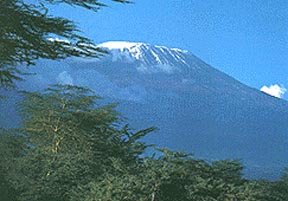
Kilimanjaro is the world’s highest free standing mountain, rising nearly 16,000' above a rolling plain that averages a little over 3000' above sea level. Kilimanjaro is composed of three extinct volcanoes: Kibo, Mawenzi, and Shira, though at “only” 13,000', Shira is not a prominent feature of the mountain. The highest point is Uhuru Peak on Kibo. After reaching a height thought to be 19,344' during its last major eruption 360,000 years ago, Kibo has been eroded by glaciers, rivers, and landslides. The mountain is losing glaciers due to global warming.
Though Kilimanjaro has always been part of the landscape to those living in east Africa, the mountain was first brought to the attention of the rest of the world by German missionary-explorer Johannes Rebmann whose account of a snow-capped peak three degrees below the equator was laughingly dismissed by scientists in 1848. It was not until 1889, when German geologist Hans Meyer, climber Ludwig Purtcheller, and local guide Yohannes Lauwo reached the summit and named it for Kaiser Wilhelm Spitze. In 1961, the newly independent country of Tanganyika cast off another reminder of its European colonial past and renamed the summit Uhuru, which means “Freedom.”
About 12,000 trekkers a year make the attempt. About half don’t make it. Sir Edmund Hillary tried unsuccessfully to reach the summit in one day, but suffered from acute altitude sickness and had to be carried down. It’s been reported that Neil Armstrong didn’t either. Martha Stewart reached the summit. The cast of the Imax film “Kilimanjaro” did not.
We did. It’s why we came.
We were a group of 13: five women and eight men ranging in age from 33 to 72; the median age was 60. We set out from the Machame Gate about noon on July 19; we had a group picture taken at the top when the sun came up at 6:30 am on July 24. In those six days, each of us achieved our collective and individual goal: the top of Africa. When we came down to the Marangu Gate, we had hiked about 65 miles, climbed through five geographic/climatic zones, froze our fingers at below zero temperatures on the summit and sweat in shirt sleeves on the humid and sunny slopes. We witnessed the sun rise and the moon set from the roof of Africa.
Several said it the hardest thing they’ve ever done. Before we left, when people would ask me why I was going, I’d think of my knees and my age and say, “Because I can.” When I think seriously about the question, in addition to the adventure and the challenge, I know it’s because I wanted to prove to myself that I could. As Sir Edmund Hillary said of Everest, “It’s not the mountain we conquer, but ourselves.”
[Note: A word about training. We met a group of twentysomething Brits, all from the London area, the day before the final ascent. In talking with them we shared where we were from and how we prepared ourselves for the climb. They had, they said bought camping gear this past spring and done some weekend camping. What about high altitude climbs, I asked. They hadn’t been able to do much; they did climb Snowdon, the highest peak in Wales at 3,560'. We don’t think most of them made it to the top, though some probably did. On the other hand, all of our group lives at altitude, most are runners, several climbed some 14ers during late June and early July, and everyone did at least some hiking above 13,000'. Painful knees have prevented me from running for nearly a year; Judy runs about 25 miles a week. Two others in the group do not run, but did a good bit of hiking in preparation. I probably did the least training, doing a couple of 13ers and some shorter, lower hikes. What does it take to be successful in a climb to over 19,000'? Physical condition is only part of the formula. Mental toughness counts at least as much.]
There are several ways to make the ascent to the summit. A network of trails, some one-way, skirt the mountain, cross the saddle to Mawenzi, the jagged peaks to the east (experienced rock climbers only), or approach from the west, south and east to the top of Kilimanjaro. Along the way there are “huts,” usually permanent metal buildings used now primarily by porters and park rangers. The huts are also campsites where there are water and toilet pits.
The Marangu Route (nick-named the “Coca-Cola Route”) is by far the most popular and easiest trail. It take five days and four nights to complete the 38 mile round trip. Seven of every eight hikers take this route, though less than half reach the summit. The Mweka Route is the steepest, most direct hike; it requires about 23 hours of difficult climbing to the summit. It is very similar to the Umbwe Route which requires a minimum of five days. Very few who attempt the summit by this route are successful. Two other routes, the Shira Route and the Lemosho Route, are less used and join up with the Machame Route after a couple of days.
Our route, the Machame Route (also known as the “Whiskey Route”) is by all accounts, the most beautiful. We completed the ascent and return in seven days covering about 50 miles.
Day 1: Machame Gate to Machame Camp (9,776').
Elevation Gain: 3936'. Distance: 6.2 miles. Time: 6 hours.
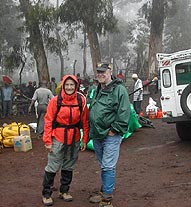
We left Moshi where Zara Kilimanjaro and African Safari Adventures is headquartered. This was not the company originally contracted to provide equipment, guides, and porters. While the porters and the cook were hard-working and friendly, Zara’s equipment was shabby and often beyond repair, and their “guides” either incompetent or unwilling to do more than lead the line of hikers; we learned nothing from them. Don’t believe their claim that they are the #1 outfitter on Mt. Kilimanjaro. Nothing could be farther from the truth! Their equipment is third rate, their guides don’t seem to know a thing about the history, geology, plants, or animals. In their favor, they did lead us to the top, and no one got hurt or sick. But there is more to being a guide than leading the line of hikers from one camp to another. Other guide companies can provide them for you.
The overcast sky turned to light rain by the time we drove about 40 miles up the mountain slope to the village of Machame deep within the rainforest zone. The road was narrow, rough, steep, and slick; Khalid, the driver of our 2WD Toyota van, bumped and skidded and forced the vehicle successfully to the area where we unloaded. The scene was chaotic as several groups prepared to begin the trek: personal packs were prepared, equipment organized, everyone had to sign in with the park official, pictures were taken, and group lines formed on the trail. We stood around practicing “jambo” and “pole pole” while we waited for everyone to sign in.
The going was slow, excruciatingly and deliberately slow. All of our group live at altitudes much higher than where we were starting and our urge to hike at a more “normal” rate was fierce. But we did not move ahead of Ali, who was the group/hike leader that day. (In a bizarre encounter at Zara’s headquarters in Moshi, Ali was pulled off the van by the woman we presume was Zara’s “manager” or at least the individual who was responsible for getting us organized and off to the mountain. Masoudi, the head “guide,” apparently wanted Ali along and, when the manager was not looking, let Ali back into the van and off we went! We don’t know what it was all about; Ali was as good a “guide” as Masoudi, but the subterfuge was puzzling and made us doubt how responsible a head “guide” Masoudi might be.)
The trail was damp and muddy the entire first day, and treacherous due to the snarl of wet roots that criss-crossed the trail. The overcast sky gave us no glimpse of the summit; with eyes watching the footing intently and the persistent low hanging cloud, we saw little of what was supposed to be one of the most beautiful sections of the trail. We remembered the mud from the Imax film but since we were hiking during the dry season the trail was not as swamp-like as shown in the movie. The wet conditions, however, slowed us almost as much as Ali’s very, very slow pace. We thought perhaps we were going slow so that our equipment and duffles would be waiting for us when we arrived. However, that was not the case. We arrived and sat in the dampness of the cloud while our equipment and personal bags staggered in over the next hour. In the dark, we set up camp and ate our first meal.
Our Boulder-based tour leader, Cindy Sonderup of Changes in Latitude, who planned our incredible trip last year to Machu Picchu, was not happy with the service, or the equipment, or with Zara Safari Adventures, or particularly with Masoudi, the head “guide,” who showed up well after dinner and the tents were up. Wait until tomorrow, we thought. Things will be better organized, the weather warmer and drier, and the trail easier.
I had a slight headache that evening; perhaps from fatigue, perhaps from my usual low water intake. In any case, I started a daily dose of diamox. We had the prescription and I thought I may as well take it “just in case.” I never had another headache or any other symptom of altitude sickness. Judy began taking diamox the third evening. She had no trouble either.
Day 2: Machame Camp to Shira Camp (12,598'). Elevation Gain: 2755' Distance: 3.6 miles. Time: 6 hours.
We woke to patches of sunshine
and our first glimpses of Kilimanjaro. The sun reflected off the ice and
it looked as though the mountain had received a fresh dusting of snow.
But, of course, it hadn’t (The white stuff is ice from the glaciers and
ice fields that are shrinking at a rate that will cause it to disappear
in 10-50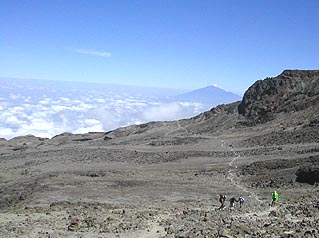 years, depending upon whose opinion you believe. There simply has not been
enough snow during the rainy season to add to the ice fields.) The mountain
looked massive and the top appeared closer than it really was. We would
skirt the base across the southern flank and make our final ascent from
the eastern slope. Our final stage would be from the southeast, which we
can’t see from where we are today.
years, depending upon whose opinion you believe. There simply has not been
enough snow during the rainy season to add to the ice fields.) The mountain
looked massive and the top appeared closer than it really was. We would
skirt the base across the southern flank and make our final ascent from
the eastern slope. Our final stage would be from the southeast, which we
can’t see from where we are today.
Upon awakening, we also discovered to our delight that we were on the boundary between the forest and the next zone: the heath or heather. For the first half of the day we raced the cloud up the mountain, dodging in and out of the mist until lunch. We had clouds with our lunch, though the air was not cold. After lunch we gained enough elevation that from then on we hiked in sunshine, above the clouds that persisted over the plains and cultivated regions. Up in this region there were fewer trees, but many flowers including lobelias, proteas, and straw flowers. The sun above 11,000' is more intense and we covered ourselves with sun screen. Several of us should have protected our lips as well; I got a fairly severe case of sunburned lips that stayed with me for at least a week after we got home. The hiking today was a slow, steady pull that we did not rush. Besides, without the clouds and the dry footing, we could enjoy the views much more than before. There was also dust everywhere; not dirt, but a fine dust that seemed to get into and onto everything. Already we began to long for a shower.
Day 3: Shira Camp to Barranco Camp (12,959').
Elevation Gain: 1' Distance: 6.5 miles. Time 6 hours.
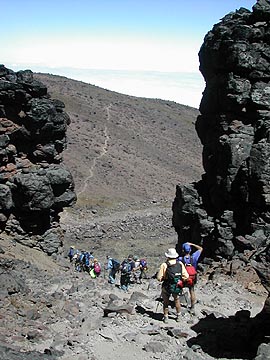
What a beautiful day for hiking! Brilliant sun, temperatures in the mid to upper 60s, a very slight breeze, and a trail mostly free of rocks (and no roots at all). Everyone was in great spirits, optimistic about the remainder of the trek, and feeling good. It was a day for pictures, especially at the Lava Tower camp where the elevation was 15,190' and we could see for miles, including Mt Meru to the west with its conical top sticking just out of the clouds. The Lava Tower is a basalt “post pile” that can be easily climbed in 15-20 minutes, but we opted to save our strength for the remainder of the climb and chose to have lunch at its base instead. The hike down from Lava Tower was as steep as the climb up as the picture on the left shows. Two hours beyond the ridge in the distance we would come to our third camp at Barranco Hut.
We
passed through tundra-like (or sub-alpine) conditions: small fragile plants
growing close to the ground. We crossed several small streams or dry stream
beds fed by glacier melt. We also got our first glimpse of the strange,
almost eerie, 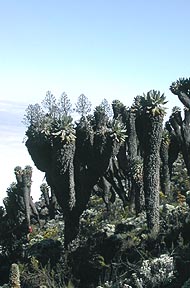 giant
senecios
that grow out of the volcanic soil to heights of 15' or more (picture on
right). Their stems serve as water reservoirs (birds drink from them) and
the dense leaf buds insulate against sub-zero temperatures. We also saw
more lobelias unlike what we have here in Colorado. On the mountain
they are tall (nine feet is not uncommon) and look like they have no blossom
at all until you look inside the leaf-like bracts that protect the flowers
inside. Birds are attracted to them, perhaps for moisture we cannot see
or for the nectar in the flowers.
giant
senecios
that grow out of the volcanic soil to heights of 15' or more (picture on
right). Their stems serve as water reservoirs (birds drink from them) and
the dense leaf buds insulate against sub-zero temperatures. We also saw
more lobelias unlike what we have here in Colorado. On the mountain
they are tall (nine feet is not uncommon) and look like they have no blossom
at all until you look inside the leaf-like bracts that protect the flowers
inside. Birds are attracted to them, perhaps for moisture we cannot see
or for the nectar in the flowers.
Barranco Camp is located at the base of the Barranco Wall, an imposing 1000' nearly straight up wall of rock with a narrow trail that at times disappears from our view below. We would tackle that in the morning.
Day 4: Barranco Camp to Karanga River (13,350'). Elevation Gain: 391' Distance: 4 miles. Time: 5 hours.
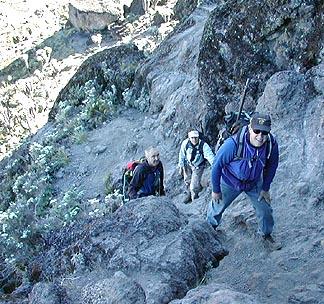
We got a leisurely start to what would be a short, almost restful day. We attacked the Barranco Wall with confidence. Watching the porters delicately balance the 60-pound loads on the their heads, each zigzagging carefully up the narrow twisting and very steep trail showed it could be done without mishap. Pole pole! We put away our trekking poles and used our hands occasionally to scramble over and around the large rocks and high steps required to make the top. An hour or so later we were standing on the top looking down to the camp below on one side and out over the plains of Tanzania to Mt. Meru on the other side. We took lots of photos, posing as though we were standing at the edge of the world.
The next leg was to descend almost as steeply into the green Karanga River valley created by the flow of clear water from the glacier above. It was the last source of water on the route to the top and the porters filled everything. We took most of the warm afternoon to bathe in the river (downstream from where the porters filled water containers), to wash the trail dust out of our hair, and even do a little laundry. Our mood was buoyant!
By this time, I felt almost as though I was hiking on “automatic.” I got up each morning with few aches and pains; I knew we had to pack up the sleeping bags and pads, our clothes and other personal gear, and get our day packs filled with water, cameras, fleece and rain gear, etc., eat breakfast and gather shortly after to begin the day’s trek. I knew we could expect several hours of slow going, beautiful scenery, a cloudless sky, a dry trail fairly clear of rocks, and that each step would bring us closer to the summit which now dominated our horizon to our north. We had conquered the steep Barranco Wall and we knew we could reach the summit without great difficulty. We talked and laughed a good bit among ourselves as we hiked. Everyone seemed to be in an optimistic, confident mood about what was ahead.
[Note on eating: Since we returned, some people have been curious about what we ate, how good the food was, and how much we ate during the trek. Unlike many hikers, our appetites did not diminish as we climbed higher. As a whole group, we ate a lot and, in general, we ate well. Lots of carbohydrates and protein. Breakfasts generally consisted of white oatmeal porridge that was surprisingly tasty, especially with the unrefined sugar as a sweetener; we always had eggs, “sausages” (though we knew they were really hot dogs and few of us ate them), and bread (which got stiffer each day so that we finally wound up calling it toast though it was never toasted) on which we put peanut butter and jam or honey. We ran out of both peanut butter and honey before the end of the trip. Lunches were often cold chicken, peanut butter, marmalade and “toast,” and occasionally a hot main dish. Suppers, which were served late—7:30—always included soup, two vegetable dishes, pasta, rice, or potatoes, a fish or chicken dish or a meat sauce to put over rice (meatless for the vegetarians), and a small serving of dessert. At most meals there was fruit—melons, papaya, oranges, bananas, etc. At every meal, and at a late afternoon snack (popcorn, bread and peanut butter, and the like) there was tea, instant coffee, and hot chocolate. In short, Happy, the cook, saw that we ate well, we ate often, and we had foods that were appropriate for the challenge of the climb.]
Days 5 and 6: Karanga River (13,350') to Barafu Hut (15,100'), the ascent to Uhuru (19,340') and down to Rau Camp (11,000'). Elevation Gain: 6000'; Elevation Loss 8,340'. Distance: 22 miles
It’s hard to separate next the two days from each other since with the exception of a five hour window of opportunity to attempt to sleep, we hiked for 36 hours. We began late in the morning (9:30) of Day 5 to climb to the Barafu Camp at over 15,000. The trail was a steady uphill hike over a good trail and the pace remained pole pole. The last 800' of elevation gain was steeper but did not slow us. Seeing the summit above us wasn’t cause for excitement, nervousness, or dread. We had simply reached the starting point for the last big effort and we were tired but determined.
Barafu
is the camp from which most everyone begins the
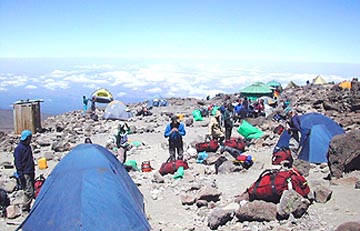 final
ascent to the summit. It sits on the edge of a ridge that falls steeply
to the south and provides a 270° view of Kibo and Mawenzi and the clouds
and distant savanna. There was a layer of smog/dust on the horizon all
around. We were on the border between the alpine desert (intense sun radiation,
a high rate of evaporation, nights below freezing, scarcity of water, and
not much soil) and the summit zone (arctic conditions: freezing cold at
night, burning sun during the day; half the oxygen than at sea level, no
plant life except for some species of lichens). We had planned for this
by bringing several layers of clothing which we would wear for only the
six or seven hours of the climb and the two hour descent back to Barafu.
final
ascent to the summit. It sits on the edge of a ridge that falls steeply
to the south and provides a 270° view of Kibo and Mawenzi and the clouds
and distant savanna. There was a layer of smog/dust on the horizon all
around. We were on the border between the alpine desert (intense sun radiation,
a high rate of evaporation, nights below freezing, scarcity of water, and
not much soil) and the summit zone (arctic conditions: freezing cold at
night, burning sun during the day; half the oxygen than at sea level, no
plant life except for some species of lichens). We had planned for this
by bringing several layers of clothing which we would wear for only the
six or seven hours of the climb and the two hour descent back to Barafu.
There must have been nearly 100 hikers plus guides and porters there that evening competing for a tent site what was moderately level and relatively free of rocks. The summit still did not look much closer than several days before though we were camped at just over three miles from the summit 4200’ above us. We ate a late lunch at Barafu, rested—talked, read, checked gear, did some preliminary packing—had an early dinner about 5:30 and went to bed, perchance to sleep. We didn’t do much of that, though when the wake-up came at 11:30 pm, it was clear we had been sleeping some.
We
dressed—three layers below our waists, four above plus wool cap and mittens.
We drank tea or hot water (no coffee this morning) and began our ascent
with the full moon giving more light than our Petzl headlamps. Two extra
guides, Salvatore and Happy, joined Masoudi and Ali in seeing that we made
it to the summit safely (or were available to stay behind in case someone
had to stop or return). Masoudi led at a
pace slower that that of a reluctant bride heading
![]() down
the aisle. We formed a tight line behind him, looking most of the time
at the feet of the person in front. Even at that, we passed several groups
and reached Stella Point (a kind of false summit) by about 5:30 and pushed
on to the summit to arrive as the sun was rising at 6:30, just as we’d
planned. In fact, we could see the full moon to the west and the sunrise
to the east, an incredible sight for us all.
down
the aisle. We formed a tight line behind him, looking most of the time
at the feet of the person in front. Even at that, we passed several groups
and reached Stella Point (a kind of false summit) by about 5:30 and pushed
on to the summit to arrive as the sun was rising at 6:30, just as we’d
planned. In fact, we could see the full moon to the west and the sunrise
to the east, an incredible sight for us all.
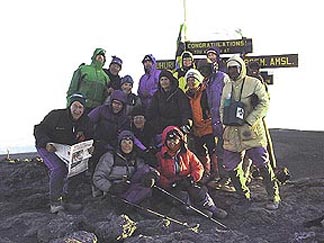
The wind at the top howled and the wind chill bottomed out at ten to twenty below zero. Camera batteries were sluggish and lenses didn’t focus quickly; fingers numbed and noses ran. Yet we managed dozens of once-in-a-lifetime pictures of individuals, couples, groups, and the whole group including the guides. It was a joyous moment of incredible achievement we won’t forget. Our exuberance warmed us.
We stayed about a half hour congratulating everyone and looking at the countryside as the sunrise permitted. We did not, unfortunately, linger to walk along the huge Southern Icefield with its strikingly vertical wall of ice or any of the glaciers; we did not explore the inner cone or hike to Reusch Crater and the Ash Pit, both landmarks of the mountain. Perhaps the next trip. We did, however, look down at the route we came up and marveled at our route and the loose volcanic dirt/rock surface that was in fact rather slippery. We schussed down this slope of volcanic scree was a series of rapid hopping steps like an erratic downhill skier.
As much as we were frustrated by pole pole pace for the past five days, it had helped to assure our success. We won’t complain on the next trek of this magnitude if the guides keep the pace very very slow.
When
we returned to camp we completed our packing, had some
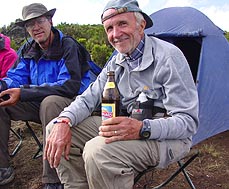 breakfast, and headed down the mountain to Rau Camp, our final overnight
camp. Because the planned return route, the Mweka Route, was closed, Rau
was a new camp, reached by a new route, the Kidia Route. The disadvantages
of these unplanned circumstances were a longer hike—we estimated that we
hiked nine miles from Barafu Camp—and a mob of hikers and porters (at least
150 to 200) that were there when we arrived. The advantages, however, were
that the privies there were relatively clean and had toilet seats (the
first we saw on the mountain); more important, to our great surprise we
could buy ice cold beer! We took off our shoes, sat back with a cold Kili,
and congratulated ourselves on our accomplishments of the past six days.
breakfast, and headed down the mountain to Rau Camp, our final overnight
camp. Because the planned return route, the Mweka Route, was closed, Rau
was a new camp, reached by a new route, the Kidia Route. The disadvantages
of these unplanned circumstances were a longer hike—we estimated that we
hiked nine miles from Barafu Camp—and a mob of hikers and porters (at least
150 to 200) that were there when we arrived. The advantages, however, were
that the privies there were relatively clean and had toilet seats (the
first we saw on the mountain); more important, to our great surprise we
could buy ice cold beer! We took off our shoes, sat back with a cold Kili,
and congratulated ourselves on our accomplishments of the past six days.
Day 7: Rau Camp to the Kidia Gate (6000'). Elevation Loss 5000'. Distance: 5 miles.
Our
final descent to the Kidia Gate took us through the same rainforest we
hiked the first day, except that this trail was drier and not as steep
as the section that left from the Machame Gate. Our spirits were high,
the sun was bright, and we knew lunch was waiting for us at a small restaurant
where the van would pick us up. Nobody ran, but we definitely picked up
our pace, talked a lot among ourselves, and began to look forward to the
next part of our trip. We were surprised to find plenty of retail opportunities
at Kidia—T-shirts, books, carvings, etc. We had clearly arrived back at
“civilization.” 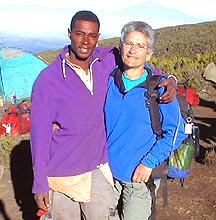 We
gave our tip for the porters to Masoudi, the head guide, as is customary,
though we’re not sure to this day if everyone shared equally and fairly
in the distribution of what we considered a very generous pool of money
for their efforts. Masoudi was not prompt in giving the porters their individual
tips; in fact, he did not appear anxious to do it at all. (Masoudi and
Ali would receive their tips separately upon our final return to Moshi
with the equipment.) When the porters finally got their money from Masoudi,
there were long faces and much loud discussion (in Swahili, of course).
We don’t know how Masoudi handled the tipping, but we do know tips are
very important and porters make much more in tips than they are paid by
the company that hires them. They had worked hard for us and we wanted
to be sure that our appreciation and respect for their efforts was demonstrated
in cold hard cash. We hope they got what they deserved.
We
gave our tip for the porters to Masoudi, the head guide, as is customary,
though we’re not sure to this day if everyone shared equally and fairly
in the distribution of what we considered a very generous pool of money
for their efforts. Masoudi was not prompt in giving the porters their individual
tips; in fact, he did not appear anxious to do it at all. (Masoudi and
Ali would receive their tips separately upon our final return to Moshi
with the equipment.) When the porters finally got their money from Masoudi,
there were long faces and much loud discussion (in Swahili, of course).
We don’t know how Masoudi handled the tipping, but we do know tips are
very important and porters make much more in tips than they are paid by
the company that hires them. They had worked hard for us and we wanted
to be sure that our appreciation and respect for their efforts was demonstrated
in cold hard cash. We hope they got what they deserved.
In addition, Judy and I tipped the cook extra (Happy fed us very well under difficult conditions) and also Hamisi, who had paid special attention to Judy’s bag and comfort during the climb. I also gave Happy my hiking pole and Hamisi my boots (the boots had been worn only on the climb, and the pair he had were very badly worn from many climbs).
When the van finally arrived, we were transported back to Moshi with the equipment and some of the porters, and then to the Serena Mountain Village Lodge where we had spent the first two nights upon arrival in Tanzania. We enjoyed long hot showers—actually it took quite a while for the water going down the drain not to be brown from the week of accumulated dust. We had several rounds of drinks before a leisurely sit down dinner. We were tired, yet exhilarated, looking forward to the next stage of our trip: the Serengeti.
THE ANIMALS
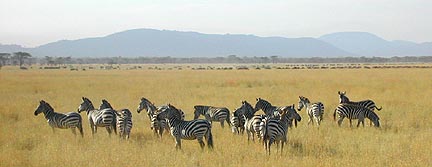 While it was the challenge of the climb that attracted us to make the trip,
we also looked forward to seeing and getting close to the large animals
for which this part of Africa is famous and holds a special fascination
for young and old alike. The prospect of seeing lions, elephants, rhinos,
zebras, etc. outside of a zoo, in their natural home, was exciting. We
also knew that we would witness the annual wildebeest
migration, a phenomenon that is difficult to describe because the number
of animals in the constantly moving herd is overwhelming: millions of wildebeests
and hundreds of thousands of zebras and Thompson’s gazelles migrate twice
a year in search of water and grasslands. That line of black specks beyond
the zebras in the photo on the right are a tiny portion of those constantly
moving wildebeests. We knew we’d be there when the
migration
crossed the western Serengeti. We didn’t relish the idea of being confined
to a vehicle looking out with binoculars and cameras ready—we would be
the animals in the cages this time!—but the idea of a safari conjured up
images of a bestial world we’d only read about in romantic adventures or
seen in movies or on the Travel Channel.
While it was the challenge of the climb that attracted us to make the trip,
we also looked forward to seeing and getting close to the large animals
for which this part of Africa is famous and holds a special fascination
for young and old alike. The prospect of seeing lions, elephants, rhinos,
zebras, etc. outside of a zoo, in their natural home, was exciting. We
also knew that we would witness the annual wildebeest
migration, a phenomenon that is difficult to describe because the number
of animals in the constantly moving herd is overwhelming: millions of wildebeests
and hundreds of thousands of zebras and Thompson’s gazelles migrate twice
a year in search of water and grasslands. That line of black specks beyond
the zebras in the photo on the right are a tiny portion of those constantly
moving wildebeests. We knew we’d be there when the
migration
crossed the western Serengeti. We didn’t relish the idea of being confined
to a vehicle looking out with binoculars and cameras ready—we would be
the animals in the cages this time!—but the idea of a safari conjured up
images of a bestial world we’d only read about in romantic adventures or
seen in movies or on the Travel Channel.
1. Arusha National Park
We
got our first taste of animal viewing at Arusha
National Park the first full day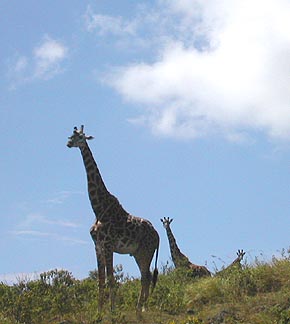 after we arrived in Tanzania. We drove about 20 miles from the Serena
Mountain Village Lodge, which is east of Arusha off the main highway
at a wide place in the road called Tengeru. When our Toyota vans left the
paved highway we got our first experience with Tanzania’s unpaved road
system. The road surface is rough: rutted, potholed, stony, and often narrow.
Speeds max out at 20 mph. It takes longer to get from one place to another
than maps would lead you to believe.
after we arrived in Tanzania. We drove about 20 miles from the Serena
Mountain Village Lodge, which is east of Arusha off the main highway
at a wide place in the road called Tengeru. When our Toyota vans left the
paved highway we got our first experience with Tanzania’s unpaved road
system. The road surface is rough: rutted, potholed, stony, and often narrow.
Speeds max out at 20 mph. It takes longer to get from one place to another
than maps would lead you to believe.
[Note: Even the paved roads, while generally smooth, don’t let cars get up to top speed for very long: in every little village that spans the highway—and they are frequent—the are “sleeping police” or speed bumps that must be respected or axles will break, heads will bump the inside roofs, and springs will bottom out.]
The object of a safari, apparently, is to see and photograph many different animals, getting as close as possible to the animals, and accurately identifying each species. This includes birds and reptiles, as well as mammals. The success depends almost entirely on the experience, patience, skill of the driver-guides—plus a good bit of luck. The guide should know where the animals are most likely to be; he should be able to quickly verify the species, gender, and age of the animal; and he should be able to keep the trip reasonably comfortable in spite of road conditions and requests of the passengers. Our guides at Arusha did a fine job.
Within no time at all we had seen more giraffes, both Reticulated and Maasai varieties, than any of us had seen in a lifetime; the same is true for several different troops of Savanna baboons, which we stopped for every time we saw them. In addition we saw our first blue monkeys and black and white colobus monkeys, warthogs, waterbucks, dikdiks, helmeted guineafowl, a variety of quail, magnificent crested cranes, and thousands of lesser flamingos (the pink ones). Though Arusha is one of the few parks that permit walking, the park requires hikers to hire an armed guide. So we stayed in the vans peering out of the tops with cameras ready. In spite of the best efforts of the guides, we did not see any elephants or hippos, both of which are live in the park. Maybe in the Serengeti.
2. The Serengeti
The
morning after we had returned from our Kilimanjaro climb, our Serengeti
guides, Abraham Mushi and Pascal Foster from Kibo Safaris,
picked us up at the Lodge for the day-long drive to our camp
in the Serengeti. We rode through Arusha, turned off the paved main highway
at Makuyuni and headed west to the northern edge of Lake Manyara on the
eastern edge of the Rift Valley. We stopped for an
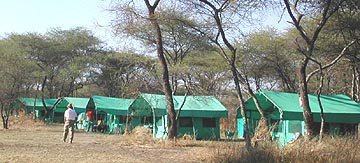 outstanding
lunch at the private estate of Willie (his last name remains a mystery
so far), the owner of Kibo Safaris, near Keratu. He joined us for lunch
and over pork chops that may have come from warthogs (their meat is reputed
to be very tender), he told us about his grandfather, a German veterinarian
who immigrated to Tanganyika and married a Maasai woman. It was Willie
who was involved with the Imax production of “Kilimanjaro,” and attended
the premier in Boston, who told us that the movie cast did not summit
the mountain. After lunch we skirted the southern rim of the Ngorongoro
Crater (which we’d tour on our return) and dropped down into the
plains of Serengeti National Park. We drove nearly 300 miles that day,
most of it over rough dirt roads, to a camp set up two days earlier just
for our group (and when we left three days later, the camp was dismantled
and everything taken away leaving no trace of our presence.) We found 8'
X 10' tents with a private shower and private outhouse facilities in back
of each tent. We even had laundry service. We slept on cots that, though
they sagged a bit and were just long enough for my 5'11" length, were light
years more comfortable than the rocky ground on the side of the mountain.
One of the taller members of the group fixed the cot size problem by putting
a therma-rest pad on top which made a very comfortable sleeping arrangement
for him. In addition, there was a large eating tent with a spacious table
for our group, a kitchen tent and tents for the staff and guides. A large
fire pit circled by comfortable chairs was the gathering place in the early
evening for drinks and conversation among our group and the guides before
dinner. It was very civilized. Kibo does it right!
outstanding
lunch at the private estate of Willie (his last name remains a mystery
so far), the owner of Kibo Safaris, near Keratu. He joined us for lunch
and over pork chops that may have come from warthogs (their meat is reputed
to be very tender), he told us about his grandfather, a German veterinarian
who immigrated to Tanganyika and married a Maasai woman. It was Willie
who was involved with the Imax production of “Kilimanjaro,” and attended
the premier in Boston, who told us that the movie cast did not summit
the mountain. After lunch we skirted the southern rim of the Ngorongoro
Crater (which we’d tour on our return) and dropped down into the
plains of Serengeti National Park. We drove nearly 300 miles that day,
most of it over rough dirt roads, to a camp set up two days earlier just
for our group (and when we left three days later, the camp was dismantled
and everything taken away leaving no trace of our presence.) We found 8'
X 10' tents with a private shower and private outhouse facilities in back
of each tent. We even had laundry service. We slept on cots that, though
they sagged a bit and were just long enough for my 5'11" length, were light
years more comfortable than the rocky ground on the side of the mountain.
One of the taller members of the group fixed the cot size problem by putting
a therma-rest pad on top which made a very comfortable sleeping arrangement
for him. In addition, there was a large eating tent with a spacious table
for our group, a kitchen tent and tents for the staff and guides. A large
fire pit circled by comfortable chairs was the gathering place in the early
evening for drinks and conversation among our group and the guides before
dinner. It was very civilized. Kibo does it right!
We
saw virtually all that the Serengeti had to show us in terms of animal
life—plus some surprises. We did see four of the “Big Five” trophy animals
that live there: elephants, lions, a cheetah, and a leopard. (The “Big
Five” trophy animal we did not see was a rhino, which we would see in the
Ngorongoro Crater later in the week.). There were, of course, many, many
zebras,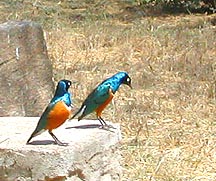 Tommies
(Thompson’s gazelles) and wildebeests (gnus). This region is also a paradise
for birders, which Judy is slowly but confidently becoming. Besides the
massive Maasai and Somali ostriches that stand in solitary dignity in the
grasses of the Serengeti, we became familiar with secretarybirds, bustards,
plovers, vultures and eagles, storks and cranes, rollers and shrikes, oxpeckers
and starlings, especially superb starlings which are gloriously colorful
and iridescent unlike their common American cousins. Judy hasn’t yet started
her “life list,” but she has a good start after this trip.
Tommies
(Thompson’s gazelles) and wildebeests (gnus). This region is also a paradise
for birders, which Judy is slowly but confidently becoming. Besides the
massive Maasai and Somali ostriches that stand in solitary dignity in the
grasses of the Serengeti, we became familiar with secretarybirds, bustards,
plovers, vultures and eagles, storks and cranes, rollers and shrikes, oxpeckers
and starlings, especially superb starlings which are gloriously colorful
and iridescent unlike their common American cousins. Judy hasn’t yet started
her “life list,” but she has a good start after this trip.
Two encounters that were memorable involved two wildebeests who provided meals for group of lurking crocodiles and a small pride of adult lions. In both instances, the wildebeests were in danger trying to cross or get a drink from a water hole on their migration. When the crocs got theirs, there was a thrashing and tearing of wildebeest body parts that churned the water muddy for some time during which the entire animal—skin, bones, hooves, meat, horns, everything—was devoured by 6-8 crocs. We watched in fascination as the feasting took place. As other wildebeests later came along, we were relieved that the crocs were satiated from the earlier meal and didn’t go after another.
We missed the initial encounter between the lion and another wildebeest, but we were there for the meal. One of several female lions apparently snatched a busily drinking wildebeest, dragged it over to a clump of bushes and, just out of our clear line of vision, began chowing down. While we were able to see only movement in the bushes, we could hear the sound of the lion’s powerful jaws crunching down on the skull of the once writhing wildebeest, killing him and then setting about eating, as they say, the lion’s share. These were the only times we saw firsthand the kind of predatory behavior of the animals of the Serengeti.
We also witnessed several lions chasing a small Thompson’s gazelle who escaped while we cheered. The lions seemed to give up rather quickly and easily. Finally, on our way in the first day, we came upon several species of vultures cleaning the bones of a gazelle that had been killed earlier by some unknown predator. Several hyenas were inching closer to get in on the meal.
 But
most of the animals were either wary of us, especially the gazelles who
darted away at the slightest motion, or simply tolerated our presence with
quiet dignity, like the topis shown in the photo on the right.
But
most of the animals were either wary of us, especially the gazelles who
darted away at the slightest motion, or simply tolerated our presence with
quiet dignity, like the topis shown in the photo on the right.
We did spot a cheetah near the road as we were driving by. Some thought he was stalking some prey we did not see in the tall grass; I though he simply was awakened from an afternoon snooze by our vehicle passing by his grassy bed near the road. He slowly stretched and moved off into the taller grass away from the road. We did not follow. The leopard, who is also known for his fast kills, was sleeping soundly in the crotch of a tree 20' to 30' off the road. He didn’t wake in spite of the sound of cameras snapping his picture. Any hyenas and jackals we saw slunk off at our approach. The same is true for a sizable “herd” of banded mongooses. The hippos, who are threatening to pond grasses (and probably anything else that comes close to them), spent their time sleeping, occasionally coming up for air, and once in a while turning over belly up in order to cool their backs which are usually exposed to the sun.
We did not see any elephants until the last full day as we were driving the “western corridor” of the Serengeti. Pascal was delighted to have found the few that we did. After all, he said there were about 6,000 in the Serengeti and we’d had bad luck until this day. He assured us we would see others in the Ngorongoro Crater tomorrow. We also came into contact with the main body of the migrating wildebeests. Lunch that day was under an flat-top acacia that had been shading a hundred or more wildebeests. We drove toward them and they vacated their shade for us. The ground was surprisingly clean and free of any scent or sign of the wildebeests.
My very personal close encounter with potentially dangerous wildlife occurred in the vehicle on our return from the first days’ outing. I felt a sharp bite on my exposed arm. I slapped at the attacker and killed him, the small body falling to the floor of the vehicle. I yelled something and picked up the body to ask Pascal to tell me what the heck had bitten me. He identified it immediately as a tsetse fly (noted for carrying sleeping sickness). He said don’t worry about it. So, I didn’t. The morning of the next day, I was watching something very intently and Judy said some insect was on my cheek. I slapped myself and more blood than I’d have ever imagined squooshed over my face and hand, even a few drops on my shirt. Pascal said it was a mosquito (some are known to carry malaria), but not to worry. So I didn’t. If I go back to Tanzania, I’m going to be sure the safari doctor Pascal Foster is along. Hakuna matata!
 [A note about the trees of the Serengeti: Most of them are
one of over 200 varieties of acacias that have become to many visitors the landmarks
of the African savanna. Noble Laureate Rudyard Kipling wrote his classic
Just So Stories in 1902, a
collection of stories set in Africa for children
of all ages. The setting of “The Elephant’s Child,” one of my favorites
in that collection, is located “ …on the banks of the great grey-green greasy
Limpopo River, all set about with fever-trees… ” (The Limpopo is where the
crocodile lived that the Elephant’s Child went to visit to find out what
crocodiles have for lunch!) I’d long thought that Kipling was being playful
with language and fanciful with his imagery; the phrase is, after all,
fun to say even if you don’t know what it really means. However, the Limpopo
River exists, of course, in southern Africa, forming borders between South
Africa and Botswana and Zimbabwe before flowing through Mozambique on its
way to the Indian Ocean. “Fever trees,” a variety of acacia: Yellow-barked
acacias (acacia xenthoploes), are all over southern Africa including the
Serengeti. So are “wait-a-bit thorn bushes,” another Kipling reference
that is not fanciful but is also a variety of acacia (acacia brevispica).
I saw both, along with the crocodile who may have been the very one that
caught the young elephant and stretched his nose to the shape now found
on all elephants.]
[A note about the trees of the Serengeti: Most of them are
one of over 200 varieties of acacias that have become to many visitors the landmarks
of the African savanna. Noble Laureate Rudyard Kipling wrote his classic
Just So Stories in 1902, a
collection of stories set in Africa for children
of all ages. The setting of “The Elephant’s Child,” one of my favorites
in that collection, is located “ …on the banks of the great grey-green greasy
Limpopo River, all set about with fever-trees… ” (The Limpopo is where the
crocodile lived that the Elephant’s Child went to visit to find out what
crocodiles have for lunch!) I’d long thought that Kipling was being playful
with language and fanciful with his imagery; the phrase is, after all,
fun to say even if you don’t know what it really means. However, the Limpopo
River exists, of course, in southern Africa, forming borders between South
Africa and Botswana and Zimbabwe before flowing through Mozambique on its
way to the Indian Ocean. “Fever trees,” a variety of acacia: Yellow-barked
acacias (acacia xenthoploes), are all over southern Africa including the
Serengeti. So are “wait-a-bit thorn bushes,” another Kipling reference
that is not fanciful but is also a variety of acacia (acacia brevispica).
I saw both, along with the crocodile who may have been the very one that
caught the young elephant and stretched his nose to the shape now found
on all elephants.]
3. The Ngorongoro Crater
One
of the most intriguing geological features of Tanzania is the twelve mile wide
Ngorongoro
Crater, one of the largest calderas in the world and a geological Noah’s
Ark—an enclosed ecosystem where wildlife abounds because there is a consistent
water supply, grasslands, and animals of prey. We counted on seeing the
“big animals,” including the rare black rhino. We also counted on seeing
the thousands of flamingos that make their home in Lake Magada, a saline
lake that is home to the brine shrimp the flamingo feed on and which give
the birds their pinkish color. Oddly, there are no giraffes in the crater
because, it is thought, their legs won’t permit the the steep climb. The
Maasai bring their cattle into the crater not only for the grass but for
the salt provided by the lake and which they can get nowhere else. There
are other spring fed lakes which provide fresh water for all the animals.
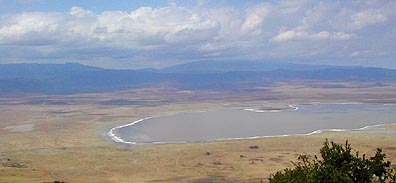 We stayed at the Ngorongoro
Serena Safari Lodge that is perched unobtrusively on the edge of the
crater. The patio off our room (and probably every room) gave us an unobstructed
view of the expanse of the crater. Unfortunately, we stayed only two nights
and were in our rooms very little of the time when there was light to see
below. We felt very pampered with an unlimited supply of hot water and
flush toilets. (The hotel gift shop provided some greatly needed retail
therapy!!). However, in retrospect, the Serengeti experience was an unqualified
and unexpected success and trip highlight. We’ve stayed at places like
the Serena Lodge, but we loved the Serengeti and the comforts of safari
camping. Again, Kibo Safari provided us with a memorable experience, both
in camp and in the bush.
We stayed at the Ngorongoro
Serena Safari Lodge that is perched unobtrusively on the edge of the
crater. The patio off our room (and probably every room) gave us an unobstructed
view of the expanse of the crater. Unfortunately, we stayed only two nights
and were in our rooms very little of the time when there was light to see
below. We felt very pampered with an unlimited supply of hot water and
flush toilets. (The hotel gift shop provided some greatly needed retail
therapy!!). However, in retrospect, the Serengeti experience was an unqualified
and unexpected success and trip highlight. We’ve stayed at places like
the Serena Lodge, but we loved the Serengeti and the comforts of safari
camping. Again, Kibo Safari provided us with a memorable experience, both
in camp and in the bush.
[A note of warning to martini drinkers: Several of our group like a martini or two in the evening and have had the same experience at several first rate bars on the trip, the Serena Safari Lodge included. Pointing to the bar menu, they asked for a very dry martini. The waiter would likely repeat the order: “Martini? Is that right?” Yes, would be the reply. A few minutes later the drink would arrive. One sip and the drinker would realize that the bartender, for some inexplicable reason, left out the gin! After this had happened a number of times, they discovered that the bartender had poured a glass of Martini & Rossi vermouth over ice! So, the best advice to martini drinkers is to order gin (single or double), like gin and tonic drinkers do (they get a bottle of tonic on the side) and a desired amount of vermouth in addition.]
On
our first morning we awoke at 5:45 am in order
 to
get an early morning visit to the crater. Our specific destination was
to view the rhinos as they emerged from the forested area where they spend
the night and “crossed the road” to forage. We got to the road in plenty
of time (along with a half dozen other groups) only to find the road closed
without explanation. The guides were furious (either because they would
have trouble finding rhinos the rest of the day—after all, there are only
16 or so in the crater—or because we all could have slept longer!). However,
we ate our box breakfast and drove through most of the crater game areas
until lunch, and another 2-3 hours into the afternoon.
to
get an early morning visit to the crater. Our specific destination was
to view the rhinos as they emerged from the forested area where they spend
the night and “crossed the road” to forage. We got to the road in plenty
of time (along with a half dozen other groups) only to find the road closed
without explanation. The guides were furious (either because they would
have trouble finding rhinos the rest of the day—after all, there are only
16 or so in the crater—or because we all could have slept longer!). However,
we ate our box breakfast and drove through most of the crater game areas
until lunch, and another 2-3 hours into the afternoon.
We did manage to see four of the sixteen black rhinos, though from quite a distance (300-400 yards), as well as elephants, lots of hippos, and thousands of the famous lesser flamingos (the pink ones; the white ones are greater flamingos and there are a few among the throng we saw.) Pascal, the guide Judy and I spent most of our time with, said we did not have very good luck today; that if we were able to came back tomorrow, we could very well have a better different experience. It all depends on weather, timing, and luck. (And the whim of park rangers who can close roads without notice and not have to give a reason!)
 However, the experience was satisfying in a number of ways. We did see thousands
of flamingos gathered in every changing groupings along the shore of Lake
Magada. Their huge numbers made a constant distinctive murmuring noise
that was always in the background as we neared the shore. There was also
an acrid, putrid smell created by the droppings of so many birds. Most
seemed to stand rather still in their places, but occasionally groups would
form some unobservable reason in bunches of 50 to 200 and move aimlessly
in one direction or another keeping as close together as possible, taking
very small steps. In a minute or two or longer, the groups would begin
to dissipate, again for no observable reason. Sometimes there were several
groups forming and marching in close formation at one time. Like the baboons,
I could have watched these birds for a long time.
However, the experience was satisfying in a number of ways. We did see thousands
of flamingos gathered in every changing groupings along the shore of Lake
Magada. Their huge numbers made a constant distinctive murmuring noise
that was always in the background as we neared the shore. There was also
an acrid, putrid smell created by the droppings of so many birds. Most
seemed to stand rather still in their places, but occasionally groups would
form some unobservable reason in bunches of 50 to 200 and move aimlessly
in one direction or another keeping as close together as possible, taking
very small steps. In a minute or two or longer, the groups would begin
to dissipate, again for no observable reason. Sometimes there were several
groups forming and marching in close formation at one time. Like the baboons,
I could have watched these birds for a long time.
Of
the big animals we saw—elephants, hippos, and
rhinos— the
hippos were most intriguing. The elephants and rhinos we saw from a distance,
the hippo pools were close to where we could drive. They didn’t move much,
but there were large numbers of them cooling in the muddy waters during
the heat of the day, rolling occasionally on their backs, short stubby
feet pointing up, cooling their backs which remained out of the water while
in their usual resting position. Such rolling around would greatly disturb
the serenity of the group which would come to life with the jostling of
those rolling around.
the
hippos were most intriguing. The elephants and rhinos we saw from a distance,
the hippo pools were close to where we could drive. They didn’t move much,
but there were large numbers of them cooling in the muddy waters during
the heat of the day, rolling occasionally on their backs, short stubby
feet pointing up, cooling their backs which remained out of the water while
in their usual resting position. Such rolling around would greatly disturb
the serenity of the group which would come to life with the jostling of
those rolling around.
At lunch, we asked our guides, Pascal and Abraham, to pose with us along with copies of our local weekly paper, the Mountain-Ear. The paper has an advertising campaign that features people in different and usually interesting places reading the paper. The photo is featured in the subscription advertisement with the slogan “People Are Reading It Everywhere,” along with a brief explanation about who’s in the photo and where the photo was taken. We had promised Pascal and Abraham that we’d take one with them along with the Kibo Safari logo (here on the side of the Land Rover we rode in for a week). I’ve included it here just in case the Mountain-Ear decides not to run the picture.
After six days chasing after Tanzania’s wildlife from our mobil cage that drove across the plains of the Serengeti and Ngorongoro, we drove back to Arusha airport and our flight to the third part of our trip: Zanzibar.
THE ISLAND
The island of
Zanzibar (zanj
is an Arabic word referring to the “non-Muslim Blacks who lived there”;
bar means “coast”) lies about 25 miles off the coast
of Africa and is part of a chain of islands which includes Pemba about 50 miles to
the north and numerous small islands situated between the two. It has been called
“The Spice Island” in reference to the cloves, cinnamon, and other spices
produced on the island that were prized in Europe, the middle east, and
Asia for centuries. Today it is often referred to as Unguja in guidebooks,
though I don’t recall anyone who used that word when talking about the
island and, therefore, I haven’t the slightest notion how to pronounce
it.
I don’t
know what it was called in the 17th to 19th centuries when it became the
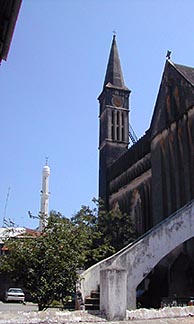 largest
slave distribution center along Africa’s east coast, but the men
and women and children who were brought here and held for sale to other
parts of the world must have called it Hell. As many as 50,000 slaves from
the interior of the continent, passed through Zanzibar in a year. Conditions
were dreadful and the death rate among those captured was horrendous. The
remains of one “holding area” can still be seen beneath the Anglican Church
in the old section of Zanzibar City called Stone
Town. Anglican missionaries, prominent among them David Livingstone,
were in large measure responsible for stopping the
slave trade in the 19th century. Though the church has only 60 or so
attending the weekly services on this 95% Muslim island, it is still an
important reminder of the island’s history.
largest
slave distribution center along Africa’s east coast, but the men
and women and children who were brought here and held for sale to other
parts of the world must have called it Hell. As many as 50,000 slaves from
the interior of the continent, passed through Zanzibar in a year. Conditions
were dreadful and the death rate among those captured was horrendous. The
remains of one “holding area” can still be seen beneath the Anglican Church
in the old section of Zanzibar City called Stone
Town. Anglican missionaries, prominent among them David Livingstone,
were in large measure responsible for stopping the
slave trade in the 19th century. Though the church has only 60 or so
attending the weekly services on this 95% Muslim island, it is still an
important reminder of the island’s history.
Zanzibar’s fortunes always rested on trade, if not in spices or slaves, then in goods from the mainland and, more lately, tourists. Time on the island of Zanzibar is a familiar part of any tour to Tanzania; it is also a place we found had been visited by many Tanzanians who looked for and could afford a vacation. We would not have missed it for the world, especially now that we know how friendly the people are, how interesting the shopping, how fine the restaurants, and clean the beaches, and how good the diving.
Zanzibar City is made up of two sections: Stone Town and Ngambo which were divided historically by a creek, which is now filled in and named Creek Road. About 160,000 people live in Zanzibar City as a whole; and 20,000 live in Stone Town, the historic and more exotic section. We stayed two night in the middle of Stone Town at the Dhow Palace Hotel in the heart of the maze of narrow, twisting streets that create patterns of light and shadow like urban slot canyons. Wandering through the narrow streets can be daunting, and getting momentarily misplaced is common. It happened to us several times. However, getting lost is another matter. It’s really hard to do because if you walk long enough we either found ourselves at the market on Creek Road or at the oceanfront. Plus, people were friendly and willing to help if asked for directions. It is a safe place to wander through; even in the evenings we felt no presence of danger, certainly no more than walking around “the Hill” section of Boulder at night, probably less.
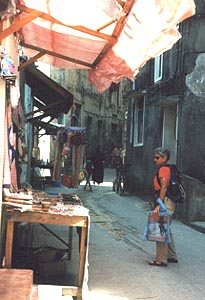 Judy and I spent the first morning seeing
the city, touring the “House of Wonders,” the former palace of the
sultans and one of the largest building on the island (though three or
four stories, it was virtually empty of anything left of those days); The
Palace Museum, the residence of the sultans filled with antique Victorian
and early 20th century furniture, plus early amenities such as piped water,
a modern bathroom, and electricity. Next to it we overlooked the cemetery;
the Old Fort built by Arabs in the early 18th century, used by the Germans
during their command of the island, and bombed and rebuilt by the British
following their defeat of Germany during WW I; the Anglican cathedral (shown
above with the white minaret of the Ibahdi Mosque in the background) which
was built upon the old slave market (a new and moving memorial sculpture
was created on the grounds of the cathedral in memory of the nameless slaves
who passed through here). The architecture of the city is a fascinating
mixture of Arabic, Indian, and and some European influences. Most striking
are the intricately carved doors throughout Stone Town, on the fronts of
homes and businesses alike. No two were the same, yet all gave the impression
of being defensible, heavy, and well protected with either inscriptions
or metal spikes to ward off intruders. They are traditionally made of breadfruit
or teak with symbols denoting, for example, security (a chain), fertility
(a fish or lotus blossom, or abundance (a date tree). One source said that
doors were so important that “the custom in Zanzibar was to carve (the
door), then erect the frame of the door before building the walls around it.”
Judy and I spent the first morning seeing
the city, touring the “House of Wonders,” the former palace of the
sultans and one of the largest building on the island (though three or
four stories, it was virtually empty of anything left of those days); The
Palace Museum, the residence of the sultans filled with antique Victorian
and early 20th century furniture, plus early amenities such as piped water,
a modern bathroom, and electricity. Next to it we overlooked the cemetery;
the Old Fort built by Arabs in the early 18th century, used by the Germans
during their command of the island, and bombed and rebuilt by the British
following their defeat of Germany during WW I; the Anglican cathedral (shown
above with the white minaret of the Ibahdi Mosque in the background) which
was built upon the old slave market (a new and moving memorial sculpture
was created on the grounds of the cathedral in memory of the nameless slaves
who passed through here). The architecture of the city is a fascinating
mixture of Arabic, Indian, and and some European influences. Most striking
are the intricately carved doors throughout Stone Town, on the fronts of
homes and businesses alike. No two were the same, yet all gave the impression
of being defensible, heavy, and well protected with either inscriptions
or metal spikes to ward off intruders. They are traditionally made of breadfruit
or teak with symbols denoting, for example, security (a chain), fertility
(a fish or lotus blossom, or abundance (a date tree). One source said that
doors were so important that “the custom in Zanzibar was to carve (the
door), then erect the frame of the door before building the walls around it.”
[Note about getting around in Stone Town: There are lots of cars, most of them taxis that zip through the narrow streets of Stone Town. Many locals also drive motor scooters which not only compete with cars on the narrow streets, but rule the even narrower alleys where cars are prohibited. On top of all that, there are bicycles everywhere. My suggestion: walk everywhere, but with caution. Things are close by; if you want to get to another part of the island, take a taxi (you can bargain with them just like the storekeepers). Don’t rent a car or scooter, unless you have a death wish. Bicycles are just in the way, something else to knock over in the rush to get from here to there. The locals have years of experience you don’t have which gives them a decided edge over any tourist.]
We returned for lunch at Blues, a restaurant built over the water at the harbor where we’d eaten the night before. From then on that day and part of the next we shopped along the narrow streets of the old town. We bought carvings, masks, jewelry, paintings/drawings, some clothing and cloth goods, and other reminders of a very different part of the world. Judy proved to be a fairly formidable bargainer, yet left each shop owner happy to have made the sale.
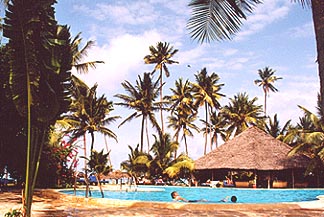 We drove 25 miles to the other side of the island across lush green fields
and the Jozani Forest, home to rare red colobus monkeys which we saw both
going and coming back. At a distance, it was hard to see the splash of
red on their heads—and they do not have the bushy tail of the their black
and white cousins—but we were assured they were the red colobus variety.
At Chwaka Bay on the Indian Ocean we left the pavement and turned north
on a dreadful dirt road ruined by lack of upkeep and heavy rains. Our destination
was the Breezes
Beach Resort, a restful tropical setting that could easily be transplanted
to a Mexican beach or Caribbean Island. The wide beach, which runs for
miles in either direction, is made of soft, talc-like sand that packs hard
for running, and is easy on the feet where it is dry. The water is warm,
nearly a clear as the Caribbean, and beyond the reef is excellent diving.
I went with a fellow hiker Rod Connolly and a young man from the Czech
Republic on a two-tank dive with Rising
Sun Dive Centre to see a healthy reef, a wide variety of colorful sponges
and coral, and my first lionfish
sightings—something I don’t see in the Caribbean—along with several rays
and schools of familiar tangs, wrasses, and other small tropicals. The
diving was excellent, though we were told the visibility will increase
to +150' at other times of the year when the weather changes and the winds
shift. Judy ran, swam, read, and enjoyed a wonderful and well deserved
massage. That evening we celebrated Austin Connolly’s 67th birthday with
cake, a serenade by the dining room staff, and dancing outside in the warm
evening air.
We drove 25 miles to the other side of the island across lush green fields
and the Jozani Forest, home to rare red colobus monkeys which we saw both
going and coming back. At a distance, it was hard to see the splash of
red on their heads—and they do not have the bushy tail of the their black
and white cousins—but we were assured they were the red colobus variety.
At Chwaka Bay on the Indian Ocean we left the pavement and turned north
on a dreadful dirt road ruined by lack of upkeep and heavy rains. Our destination
was the Breezes
Beach Resort, a restful tropical setting that could easily be transplanted
to a Mexican beach or Caribbean Island. The wide beach, which runs for
miles in either direction, is made of soft, talc-like sand that packs hard
for running, and is easy on the feet where it is dry. The water is warm,
nearly a clear as the Caribbean, and beyond the reef is excellent diving.
I went with a fellow hiker Rod Connolly and a young man from the Czech
Republic on a two-tank dive with Rising
Sun Dive Centre to see a healthy reef, a wide variety of colorful sponges
and coral, and my first lionfish
sightings—something I don’t see in the Caribbean—along with several rays
and schools of familiar tangs, wrasses, and other small tropicals. The
diving was excellent, though we were told the visibility will increase
to +150' at other times of the year when the weather changes and the winds
shift. Judy ran, swam, read, and enjoyed a wonderful and well deserved
massage. That evening we celebrated Austin Connolly’s 67th birthday with
cake, a serenade by the dining room staff, and dancing outside in the warm
evening air.
A TRIBUTE TO GOOD PLANNING
Finishing our nearly three
week trip in this tropical resort setting showed great planning. You can
see how it went: (1) We worked hard for a week climbing the highest mountain
in Africa, perhaps the hardest physical achievement in my life so far.
(2) We spent another week searching out and photographing the greatest
animals the Serengeti and Ngorongoro Crater have to offer. (3) We followed
this by engaging in two days of fiercely competitive retail therapy in
Stone Town (Fortunately, we had a day of preparation in the bustling city
of Arusha early in our trip where we learned some of the finer points of
saying No! to the third and fourth offers, walking away, only to be chased
down three blocks later with a fifth and lower offer). (4) Finally, we
prepared for the 27-hour return flight home by relaxing by and on a great
sandy beach, drinking gin and tonic and cold Kilis, swimming in the crystal
waters of our resort pool, enjoying an hour-long full body massage, or
diving in an Indian Ocean coral reef that few people ever get the chance
to see.
Well done, Cindy. You and
the folks at Boulder’s Changes in Latitude
again have earned high honors from the entire group you brought together
for this incredible trip.

A Serengeti Sunset
 |
|
|